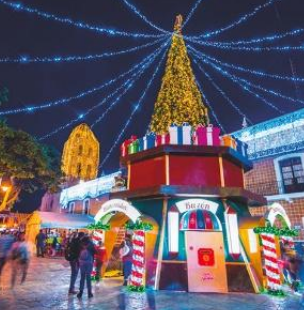Day of the Dead etiquette: Your guide to the holiday as a foreigner
Not so long ago, many Anglos would be repulsed by the whole idea of treating death as anything but something to be ignored at all costs. Acceptance of Day of the Dead in much of the United States – and depictions of it in movies like “Spectre” and “Coco” – have changed that.
Religion and identity meet in Mexico City’s Iztapalapa
The borough of Iztapalapa may not have one of the best reputations in Mexico City, but it is also home to one of Mexico’s most important annual events — its Passion Play.
It is not the only passion play in Mexico by any means, but it is the oldest, most elaborate and best-known, celebrating its 180th edition this year.
CDMX celebrates Carnival; you just have to know where to look
Mexico is not the first country you associate with Carnaval celebrations. True, it lacks the famous mega-celebrations of Río de Janeiro, Venice and New Orleans, but carnaval celebrations not only exist here, they have a unique history, perhaps best reflected in Mexico City.
Guadalupe’s pilgrims an annual logistical challenge for the capital
The pilgrims’ focus is a small hill on the northern edge of Mexico City called Tepeyac. Once a year, millions of them travel from all over Mexico (and other countries) to thank Our Lady of Guadalupe for favors granted, to ask for a miracle, or simply to pay homage to the dark-skinned version of the Virgin Mary in her home, the Guadalupe Basilica.
Want to see Day of the Dead festivities in Mexico but not sure where to go? Try these starter ideas
So, you’re visiting here, or recently moved to Mexico, and you finally have the chance to experience Day of the Dead in the country where it originated, but what if you don’t know where to find the celebrations?
Firstly, you should know that there are actually different kinds of celebrations of Day of the Dead. The most important distinction is between those that are traditional, based on centuries and even millennia of tradition, and those done for entertainment.
Ofrendas: How Día de Muertos altar tradition shapes Mexico’s identity
One of the most ubiquitous manifestations of Day of the Dead is the ofrenda, a word that can be translated both as “altar” and “offering” because it is indeed both.
These highly decorated tables filled with food, photos, candles, whimsical figures and more have their origins in the Mesoamerican belief that the dead return home once a year. Mexicans prepare for that occasion not in dread but rather as a family reunion.
Mexicans may run with papier-mache bulls but it can still be dangerous
Centuries ago, in the Old World, a kind of a cult focusing on bulls emerged, taking on various forms with the passage of time. By the time of the Spanish conquest of Mexico, bulls were no longer regarded as gods, but they still held an important role in the imagination and in local celebrations, the most famous in Spain being the running of the bulls in Pamplona.
Mexico has two kinds of carnival — one you’ve probably never seen
Mexico has one kind of carnival celebration, similar to what you’d see elsewhere in the world, but another kind is uniquely Mexican.
Originally Mesoamerican, the piñata keeps evolving through the centuries
Few things evoke Mexico in our minds as does the traditional star-shaped piñata.
Piñatas are extremely important to Mexican popular culture. They are ubiquitous at birthdays, for example, but the most traditional ones are associated with Christmas.
Coming to terms with grief: the psychological perks of Day of the Dead
The animated film Coco has probably done more than anything else to take the “ew” factor out of Day of the Dead for those of us who grew up with nothing like it.
This is great because there are good psychological reasons for celebrating it.
















